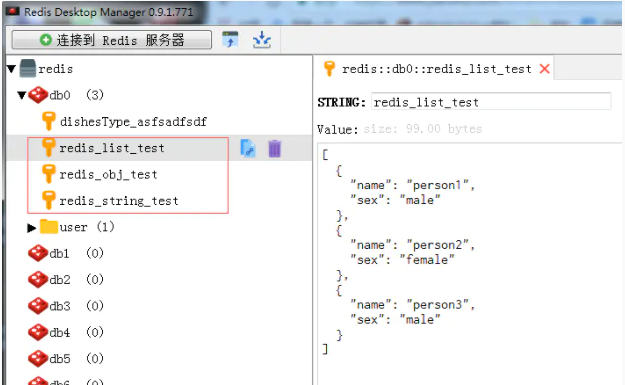Redis在项目中的使用(JedisPool方式)
作者:HongMaJu
springboot中redis相关配置
1、pom.xml中引入依赖
<dependency> <groupId>redis.clients</groupId> <artifactId>jedis</artifactId> <version>2.9.0</version> </dependency>
2、springboot的习惯优于配置。也在项目中使用了application.yml文件配置mysql的基本配置项。这里也在application.yml里面配置redis的配置项。
spring:
datasource:
# 驱动配置信息
url: jdbc:mysql://localhost:3306/spring_boot?useUnicode=true&characterEncoding=utf8
username: root
password: root
type: com.alibaba.druid.pool.DruidDataSource
driver-class-name: com.mysql.jdbc.Driver
# 连接池的配置信息
filters: stat
maxActive: 20
initialSize: 1
maxWait: 60000
minIdle: 1
timeBetweenEvictionRunsMillis: 60000
minEvictableIdleTimeMillis: 300000
validationQuery: select 'x'
testWhileIdle: true
testOnBorrow: false
testOnReturn: false
poolPreparedStatements: true
maxOpenPreparedStatements: 20
redis:
host: 127.0.0.1
port: 6379
password: pass1234
pool:
max-active: 100
max-idle: 10
max-wait: 100000
timeout: 0
springboot中redis相关类
- 项目操作redis是使用的RedisTemplate方式,另外还可以完全使用JedisPool和Jedis来操作redis。整合的内容也是从网上收集整合而来,网上整合的方式和方法非常的多,有使用注解形式的,有使用Jackson2JsonRedisSerializer来序列化和反序列化key value的值等等,很多很多。这里使用的是我认为比较容易理解和掌握的,基于JedisPool配置,使用RedisTemplate来操作redis的方式。
redis单独放在一个包redis里,在包里先创建RedisConfig.java文件。
RedisConfig.java
@Configuration
@EnableAutoConfiguration
public class RedisConfig {
@Bean
@ConfigurationProperties(prefix = "spring.redis.pool")
public JedisPoolConfig getRedisConfig(){
JedisPoolConfig config = new JedisPoolConfig();
return config;
}
@Bean
@ConfigurationProperties(prefix = "spring.redis")
public JedisConnectionFactory getConnectionFactory() {
JedisConnectionFactory factory = new JedisConnectionFactory();
factory.setUsePool(true);
JedisPoolConfig config = getRedisConfig();
factory.setPoolConfig(config);
return factory;
}
@Bean
public RedisTemplate<?, ?> getRedisTemplate() {
JedisConnectionFactory factory = getConnectionFactory();
RedisTemplate<?, ?> template = new StringRedisTemplate(factory);
return template;
}
}
- 在包里创建RedisService接口的实现类RedisServiceImpl,这个类实现了接口的所有方法。
RedisServiceImpl.java
@Service("redisService")
public class RedisServiceImpl implements RedisService {
@Resource
private RedisTemplate<String, ?> redisTemplate;
@Override
public boolean set(final String key, final String value) {
boolean result = redisTemplate.execute(new RedisCallback<Boolean>() {
@Override
public Boolean doInRedis(RedisConnection connection) throws DataAccessException {
RedisSerializer<String> serializer = redisTemplate.getStringSerializer();
connection.set(serializer.serialize(key), serializer.serialize(value));
return true;
}
});
return result;
}
@Override
public String get(final String key) {
String result = redisTemplate.execute(new RedisCallback<String>() {
@Override
public String doInRedis(RedisConnection connection) throws DataAccessException {
RedisSerializer<String> serializer = redisTemplate.getStringSerializer();
byte[] value = connection.get(serializer.serialize(key));
return serializer.deserialize(value);
}
});
return result;
}
@Override
public boolean expire(final String key, long expire) {
return redisTemplate.expire(key, expire, TimeUnit.SECONDS);
}
@Override
public boolean remove(final String key) {
boolean result = redisTemplate.execute(new RedisCallback<Boolean>() {
@Override
public Boolean doInRedis(RedisConnection connection) throws DataAccessException {
RedisSerializer<String> serializer = redisTemplate.getStringSerializer();
connection.del(key.getBytes());
return true;
}
});
return result;
}
}
在这里execute()方法具体的底层没有去研究,只知道这样能实现对于redis数据的操作。
redis保存的数据会在内存和硬盘上存储,所以需要做序列化;这个里面使用的StringRedisSerializer来做序列化,不过这个方式的泛型指定的是String,只能传String进来。所以项目中采用json字符串做redis的交互。
到此,redis在springboot中的整合已经完毕,下面就来测试使用一下。
5. springboot项目中使用redis
在这里就直接使用springboot项目中自带的单元测试类SpringbootApplicationTests进行测试。
@RunWith(SpringRunner.class)
@SpringBootTest
public class SpringbootApplicationTests {
private JSONObject json = new JSONObject();
@Autowired
private RedisService redisService;
@Test
public void contextLoads() throws Exception {
}
/**
* 插入字符串
*/
@Test
public void setString() {
redisService.set("redis_string_test", "springboot redis test");
}
/**
* 获取字符串
*/
@Test
public void getString() {
String result = redisService.get("redis_string_test");
System.out.println(result);
}
/**
* 插入对象
*/
@Test
public void setObject() {
Person person = new Person("person", "male");
redisService.set("redis_obj_test", json.toJSONString(person));
}
/**
* 获取对象
*/
@Test
public void getObject() {
String result = redisService.get("redis_obj_test");
Person person = json.parseObject(result, Person.class);
System.out.println(json.toJSONString(person));
}
/**
* 插入对象List
*/
@Test
public void setList() {
Person person1 = new Person("person1", "male");
Person person2 = new Person("person2", "female");
Person person3 = new Person("person3", "male");
List<Person> list = new ArrayList<>();
list.add(person1);
list.add(person2);
list.add(person3);
redisService.set("redis_list_test", json.toJSONString(list));
}
/**
* 获取list
*/
@Test
public void getList() {
String result = redisService.get("redis_list_test");
List<String> list = json.parseArray(result, String.class);
System.out.println(list);
}
@Test
public void remove() {
redisService.remove("redis_test");
}
}
class Person {
private String name;
private String sex;
public Person() {
}
public Person(String name, String sex) {
this.name = name;
this.sex = sex;
}
public String getName() {
return name;
}
public void setName(String name) {
this.name = name;
}
public String getSex() {
return sex;
}
public void setSex(String sex) {
this.sex = sex;
}
}
在这里先是用@Autowired注解把redisService注入进来,然后由于是使用json字符串进行交互,所以引入fastjson的JSONObject类。然后为了方便,直接在这个测试类里面加了一个Person的内部类。
一共测试了:对于string类型的存取,对于object类型的存取,对于list类型的存取,其实本质都是转成了json字符串。还有就是根据key来执行remove操作。
获取字符串:

获取对象:

获取list:

redis管理客户端数据:

到此,测试完成,对于常用的一些数据类型的转换存取操作也基本调试通过。所以本文对于springboot整合redis到此结束。
到此这篇关于Redis在项目中的使用(JedisPool方式)的文章就介绍到这了,更多相关Redis项目中使用内容请搜索脚本之家以前的文章或继续浏览下面的相关文章希望大家以后多多支持脚本之家!
